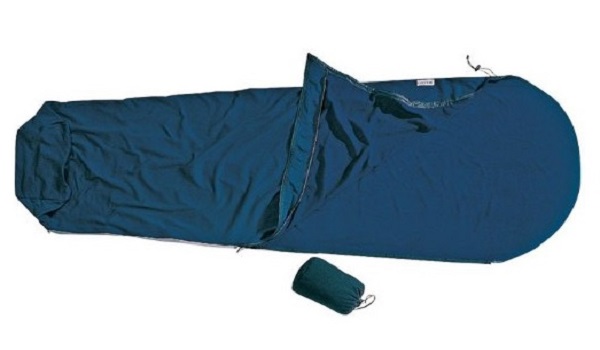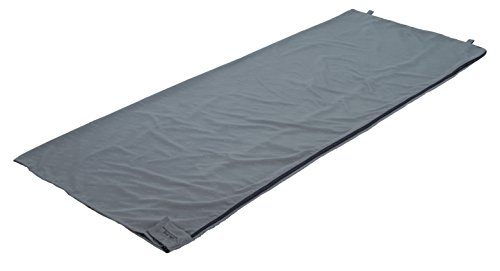Recently, I’ve done a couple of posts on how to kit yourself out with appropriate sleeping kit if you plan to camp out while out on the trail. So far we’ve looked at how best to choose a sleeping bag and the necessity of a camping roll mat.
You can get away with a good bag and a roll mat for a reasonably good nights sleep on the trail but one final accessory that I want to look at today is a sleeping bag liner.
So What is a Sleeping Bag Liner?
A sleeping bag liner is kind of like a bed sheet for a sleeping bag. It has the same shape as a sleeping and you use it in the same way and in conjunction with your sleeping bag.
Basically you put your sleeping bag liner inside your sleeping bag and get into it in exactly the same manner as you would your sleeping bag. This provides a liner or sheet between you and your sleeping bag?
As with Sleeping bag’s, sleeping bag liners can come in different shapes and sizes.
When referring to shapes, I am talking here of either Rectangular or Mummy. These are the two most common shapes of sleeping bags so it makes sense to get a sleeping bag liner in the same shape as your sleeping bag.
 Pictured above is the Cocoon Silk MummyLiner. Silk is an excellent although more expensive option for a liner.
Pictured above is the Cocoon Silk MummyLiner. Silk is an excellent although more expensive option for a liner.
Pictured above is the ALPS Mountaineering MicroFiber Rectangle Sleeping Bag Liner. Another excellent liner choice if you don’t want to spend extra for the silk option.
Similarly, with regards to size, if you get one that fits the size of your bag, and assuming you’ve already checked that you into fit your bag of course 🙂 , it should be a comfortable fit for your body.
This may seem like stating the obvious but I have a friend who just picked up a cotton sleeping bag liner in a store without checking the size of it. I have no idea why! Long story short, it was way too small for him as he’s a big guy. It was more or less useless then.
What’s the Point of it?
Well, as far as camping goes, the main advantage is that it keeps your sleeping bag from getting dirty or sweaty from the inside. After a days hiking, chances are you’re not going to be the cleanest you’ve ever been. When you take off your gear and get into your sleeping bag, you don’t really want to have the dirt and sweat from the trail bonding with the inside of your sleeping bag.
Instead if you have a sleeping bag liner, it will do that for you and protect the inside of your bag. The main advantage of this is that a sleeping bag liner is pretty thin and lightweight. Therefore, it is a lot easier to wash a sleeping bag liner than having to wash a sleeping bag.
Using a liner will help cut down on the need to wash your bag as much as you would need to if you didn’t use one.
Finally, a liner will add a little extra bit of warmth to your nights sleep so it’s worth keeping that in mind too. It is no way enough on it’s own but it will add a marginal amount more to the performance of your sleeping bag.
Are they Heavy?
No, Sleeping bag liners are designed to be lightweight so they don’t add much weight to your pack. As already mentioned, they’re similar to a bed sheet in thickness and they usually come in a carry case which it rolls neatly up into (see bag in mummy picture above).
They are usually made from either cotton or silk. My understanding is that the silk one is lighter, a little less bulkier, stronger and probably a little more comfortable than the cotton ones available. The silk one also dries quicker than a cotton one and handles temperature changes a bit better.
The one I have is a cotton one and it worked just fine. I’ve used it in the huts in the Alps as well as camping and it worked perfectly.
How Much are They?
A sleeping bag liner should definitely not break the bank. For a cotton one, you are looking at anywhere from $20.00 to $40.00. As mentioned above, is you want a silk one, they are more expensive and you’re talking anywhere from $50.00 to $80.00.
Other Uses
A sleeping bag liner is not only advantageous while making camp. As I wrote about a few months back I climbed Mont Blanc in the Alps. As part of that I stayed in the ‘huts’. Huts are accommodation you can book to stay in while hiking in the Alps.
The huts are basic but comfortable and they provide beds which will have some form of bedding. However, we were advised to take a sleeping bag liner with us as recently the powers that be were saying that a sleeping bag liner was a requirement.
Now, it seems this latest requirement is not always enforced and no-one checked when I was there. However, regardless I was grateful to have one with me anyway as I imagine the beds in the huts get a lot of traffic through them. I have no doubt they’re washed regularly enough but having your own protective barrier in the form of a sleeping bag liner was definitely a good idea.
Extending on from this use, I really see that if you are planning to do some backpacking, or perhaps a longer trek like the Camino de Santiago on which you plan to stay in the Auberges (hostels), utilizing a sleeping bag liner would seem to make a lot of practical sense. Those beds will have a lot of traffic through them so I think it’s nice to have your own protective sleeping layer.
Conclusion
If you’re going to head out for a nights camping or if you’re planning to do a bit of backpacking and stay in hostels as you travel, a sleeping bag liner is a good addition to your kit. They’re practical and they don’t cost the earth so I recommend looking into getting one.
Now, for longer backpacking trips where you’re carrying all your kit on your back, in truth, a sleeping bag liner probably takes up too much valuable space which could be used to carry something much more functional. However, they are still worth a look when kitting your sleeping system out.
So, that’s pretty much all I wanted to cover with regards to sleeping kit for a nights camping on the trail. With a good sleeping bag, camping roll mat and a sleeping bag liner, you should have the guts of what you need for a reasonable nights sleep under the stars in your tent.
Do you use a sleeping bag liner? Cotton or Silk? I’d love to hear your thoughts in the comments below!
